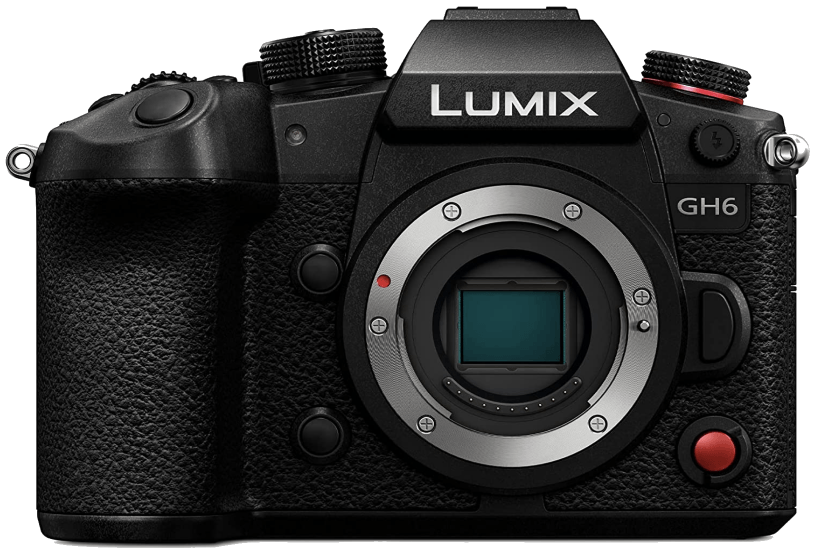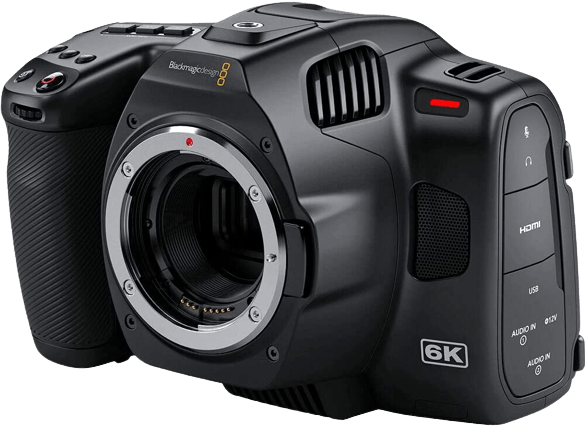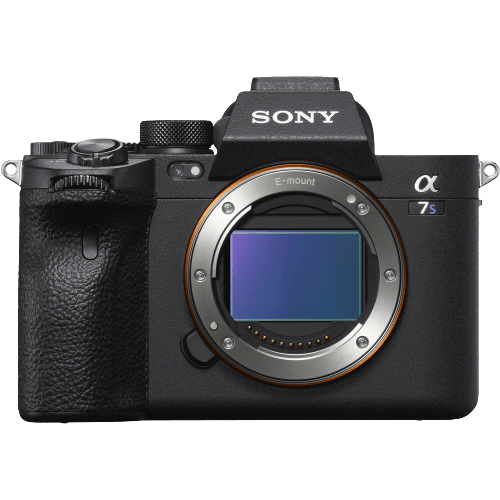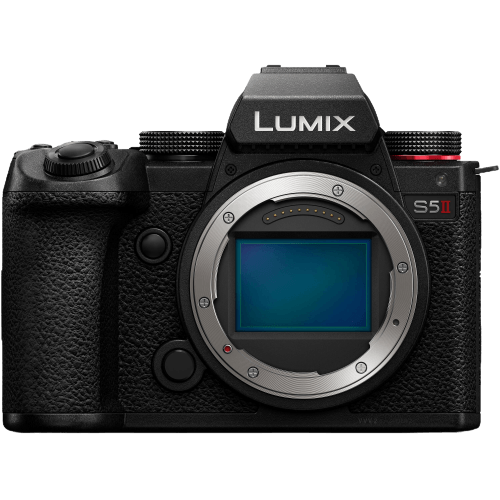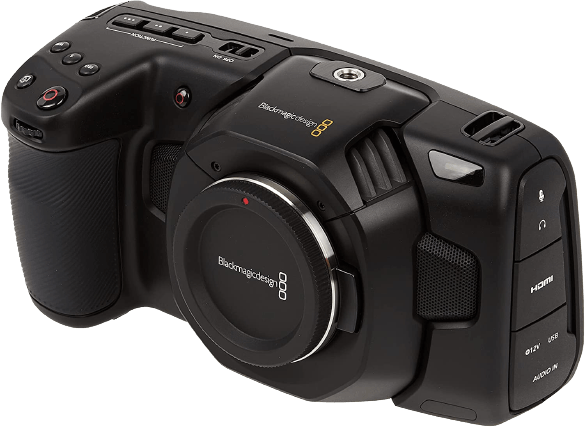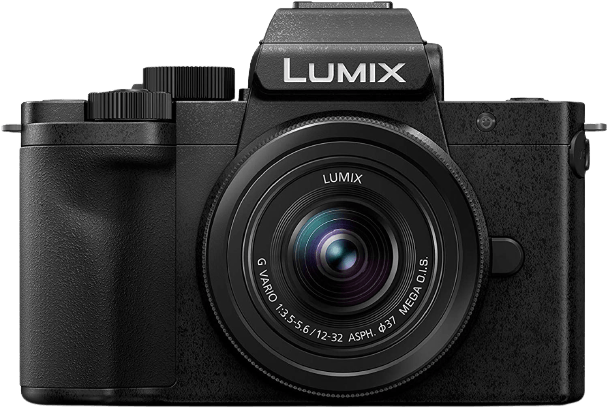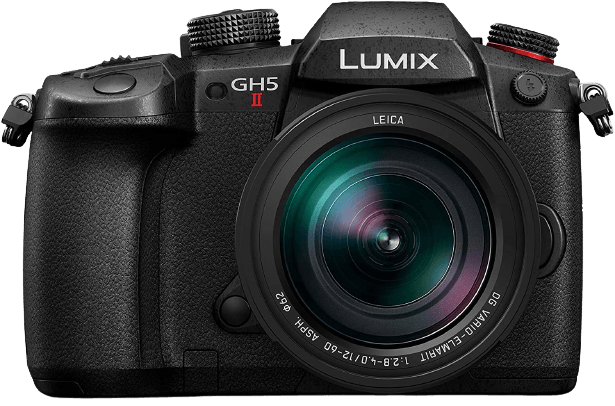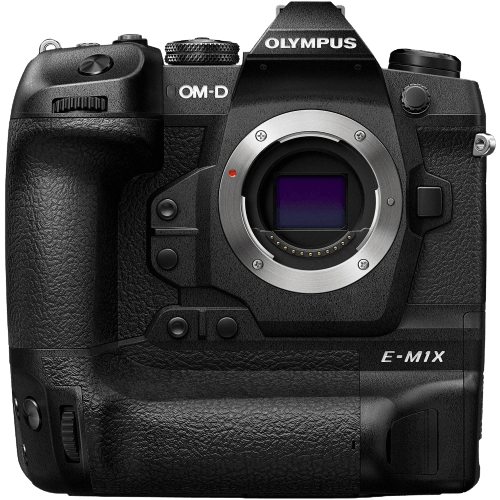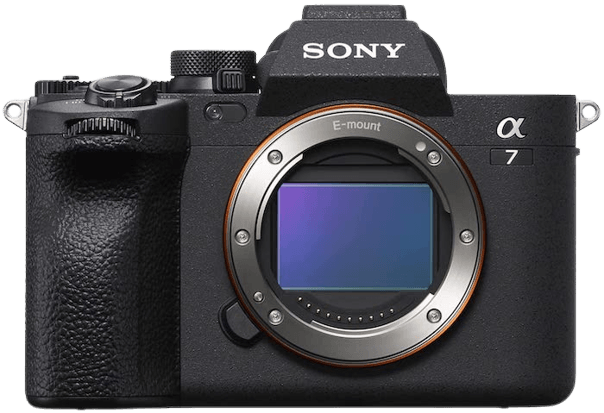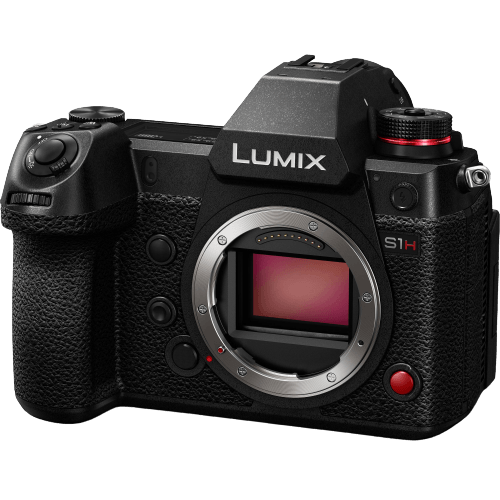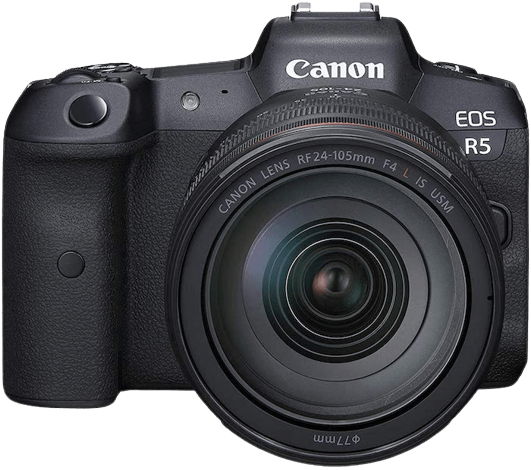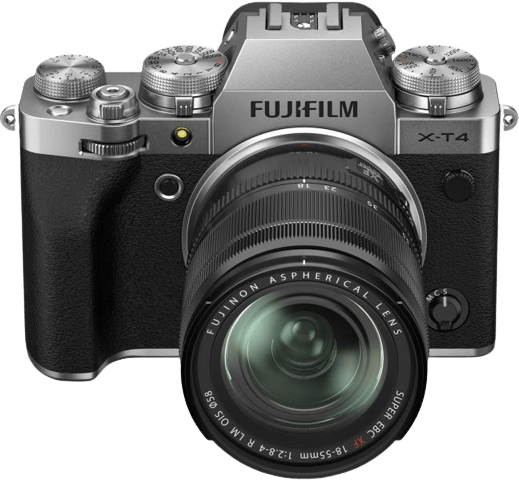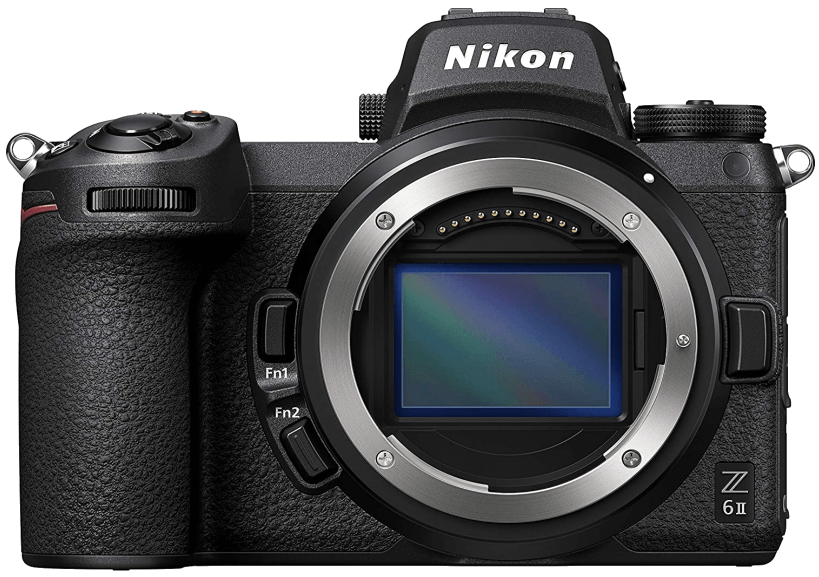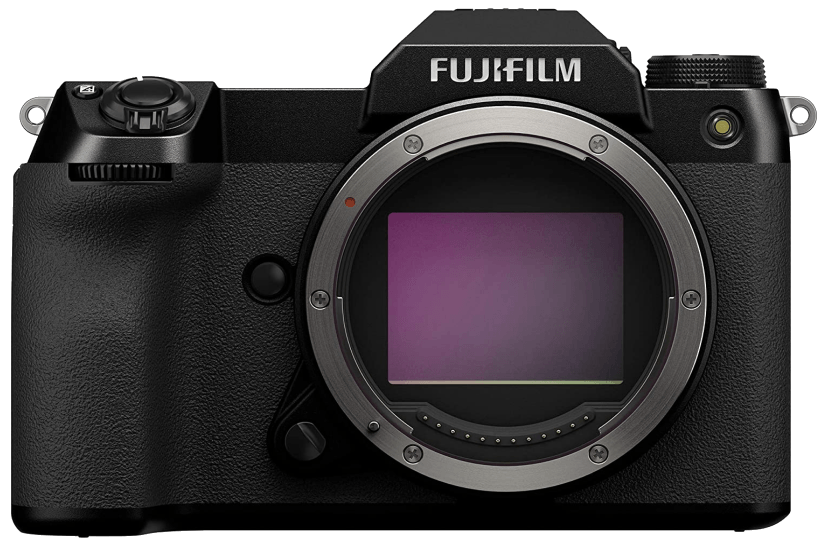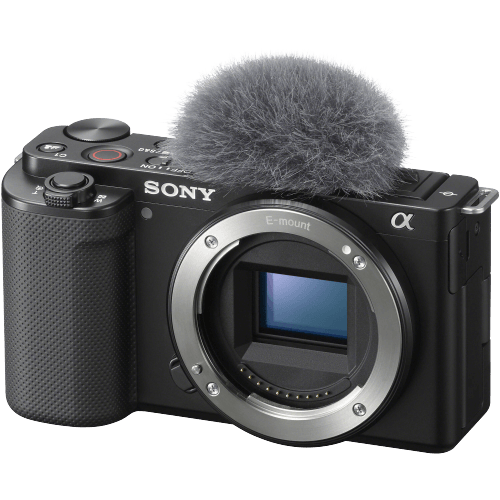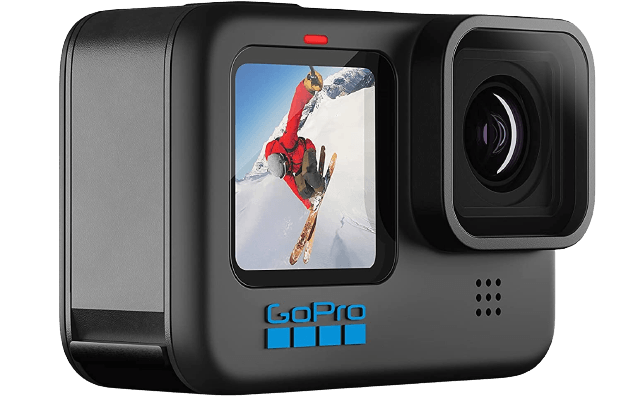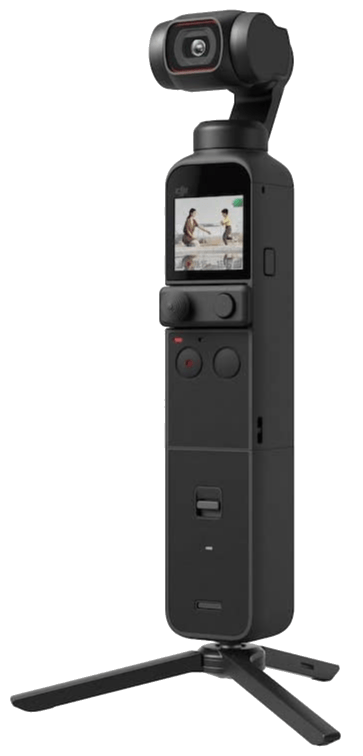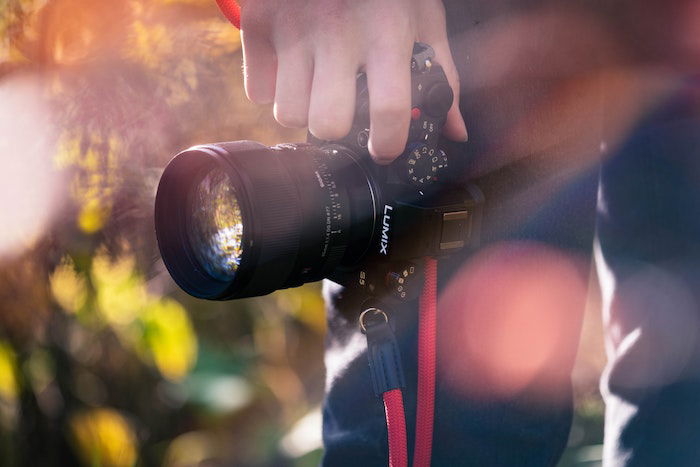Most cameras made in the last few years have video functions. You can now get handheld cameras that produce professional-quality video. Our number one camera is the Panasonic Lumix GH6. It is a compact camera with extremely high video resolution. And it has a range of extra features perfect for videography.
What Is the Best Camera for Videography?
We present a nice mix of high-quality cameras for video. But you can jump to the end to read our buying guide. There we summarize the different photography niches and uses for video. And we recommend the best video cameras for each one.
17 Best Cameras for Videography
The Panasonic Lumix GH6 takes the top spot as the best camera for videography. That is because of its amazing video resolution and many features. One of the top features is its 7.5-stop dual image stabilization. This is amazingly high. And it allows you to take smooth-looking videos without using a rig. The GH6 has all the great abilities of the GH5 II plus a lot more. Lumix cameras can shoot video in 5.7K at 60 fps (frames per second). And the camera also takes CF express cards to get the fastest possible processing. With 4K, it can record up to 120 fps. And it shoots 240 fps in Full HD. This is plenty to give you a smooth video experience… even when shooting fast-paced subjects! The camera lets you internally record in ProRes 422 HQ and ProRes 422 codec videos. (Developed by Apple.) This is industry-standard quality. But you usually need an external camera screen to access these features. The GH6 is for people serious about videography. It is for professionals who need a smaller, more portable camera in their kit bag. And it leads the market in handheld video abilities. Panasonic is the master of hybrid cameras. Videographers should see our full list of the best Panasonic cameras. The Blackmagic 6K is the best video camera in their Pocket Cinema range. The camera features a Super 35 mm sensor equal to a full frame camera. The camera can capture a much narrower depth of field than its 4K sibling mentioned below. This also allows the camera to capture colors more accurately… even more so when combined with the technology that handles the files. Like the 4K version, it has a beautiful five-inch display screen. You can tilt this both upward and downwards. And it makes shooting awkward angles a breeze. Plus, it’s a touchscreen for convenient control. Another great extra feature is the optional electronic viewfinder. It gives you a high-quality OLED display, ensuring you see everything in focus. The Blackmagic 6K also captures images in 21.2 MP image quality. So you can still take great stills as well! There are some great Blackmagic cinema camera bundles, too. Sony’s a7S III is high on this list due to its excellent video features and light size and weight (3.1 lb / 1.4 kg). It’s amazing how far technology has progressed for a handheld, cinema-quality camera. Even 10 to 15 years ago, a device bigger than this couldn’t capture 4K video at 120 fps! The image quality in this camera may seem low. But its backlit sensor makes the 12.2 MP seem like a lot more. And it also has an extended ISO of up to 409,600 to help with exposure in low light. Another aspect that sets Sony apart is its S-Cinetone color science. This has been adopted from their more serious film cameras. And now it features in these small, handheld cameras. It is spectacular for natural skin tones and detail in shadows and highlights. You can tell the a7S III is aimed at filmmakers. It has small details, like a video shooting button next to the regular shutter release. Sony designed it for video recording. And it just makes practical sense. The Panasonic Lumix S5 II is another great mirrorless camera for video on our list. It has cinema-quality video capabilities. But you can also take great photos. Its full frame sensor lets you shoot incredible 6K video. And that video resolution has a 30 fps frame rate. This is in a 4:2:2 color format for more definition. You can also record 4K at 60 fps for super-smooth footage. And there’s a 120 fps option in full HD. That gives you breathtaking slow-motion footage. This gives you fantastic options for everything from recording sports to cinematography. Its advanced video autofocus (AF) is one of the top selling points for videographers. It has accurate face detection and subject tracking. Its AF is highly reliable for photography. But it’s even more impressive when recording video. It locks onto subjects, tracking them even in busy environments. The Active Image Stabilization system gives you a whole new level of smoothness. It reduces camera shake when recording handheld. And it stabilizes your video when recording walking or tracking shots. You no longer need a camera stabilizer or gimbal for these shots. It’s a revelation for videographers. And the photography specs are also impressive. That’s why it’s one of the best hybrid cameras on the market. A 24.4 MP resolution from a full frame sensor isn’t record-breaking. But it does have a 50 ISO setting, helping you maximize image quality. You also have five-axis stabilization for better exposure control. The Lumix S5 II is lightweight and compact for a full frame camera. This also makes it the perfect video camera for travel. It’s a durable camera with thorough weatherproofing. Plus, it fits nicely in your travel camera bag. You’ll worry more about the size of the lens rather than the size of the camera body! The Blackmagic Pocket Cinema 4K is the first camera on our list for filmmaking. This camera is for professionals familiar with film-industry equipment. Or it’s for those comfortable with manual video settings. It looks like a DSLR. But its buttons and functions are all geared toward filmmaking. It may take some time for photographers to adjust to them. But videographers will feel right at home. My favorite feature is the huge five-inch screen. Blackmagic understands video shooters need to pay more attention to detail. So they put a minimal amount of buttons on the back. Instead, they extended the screen size. So many features are touchscreen buttons or found on other parts of the camera. I like the ND filter buttons that are within thumb reach. They are extremely helpful for controlling light in tough situations. You can also save all files in open formats with the Pocket Cinema 4K. This means you don’t have to waste time transcoding them in the editing process. And all the files are compatible with all post-production software. So you can use the editing software that works best for you! The Panasonic Lumix G100 is the perfect entry-level videography camera. It’s small and compact. It’s easy for photography, video, and streaming. And it has excellent features for top-quality media production. It’s also the most affordable camera on this list. So this is the camera beginner videographers need. Despite its compact size, it delivers fantastic video results. You can record with crystal-clear 4K resolution. And you have a choice of 24 or 30 fps frame rates at full resolution. You also have faster frame rates if you drop down to Full HD. This includes a smooth 60 fps option. The five-axis image stabilization works for photography and video. It reduces camera shake, letting you shoot walking shots without external stabilization. There’s a rotating touchscreen that’s ideal for shooting vlogs. And you have ports for external microphones for sound recording. Plus, the camera tracks sound, giving you 360-degree audio. This camera is also great for photography. It uses a Micro Four Thirds sensor. And it gives you an image resolution of 20 MP. That’s excellent for a camera of this size. It gives you fantastic detail and vibrant colors. And it beats most smartphone cameras by some distance. (You can read our article on the best Micro Four Thirds cameras.) The AF system is excellent for stills and videos. The camera has Wi-Fi connectivity. And you can also use it as a webcam. That’s why it’s on our list of the best streaming cameras. The Panasonic Lumix G100 is a versatile little camera. It has fantastic features for video production. And it’s very beginner-friendly. It’s the best videography camera for beginners. The Pansonic Lumix GH5 II was one of the first hybrid cameras that focussed its development on videography. It can shoot Cinema 4K image quality at 60 fps. And this is recorded in the industry standard 4:2:2 color format and 10-bit quality. So there is no compromise in the color handling. This camera is also geared to tackle high-quality live streaming. It can connect both with and without wires to your devices. So you can shoot 4K video at 30 fps in a live format. The other feature that stands out with the GH5 II? You can charge it through a USB power supply. This extends your battery life and gives you one less problem to think about. It’s great for studio-based shoots that can sometimes consist of long hours. And another good reason for choosing a Panasonic camera? Its lenses are developed in conjunction with Leica. Good glass always makes a huge difference in image quality and sharpness. And Leica lenses guarantee high-quality glass. Right off the bat, Olympus claims to have the “world’s-best” image stabilization. This, combined with its incredible weatherproofing, makes the OM-D E-M1X an ideal outdoor camera. The weatherproofing includes rubber rings for the input plugs. And you can attach a mic and a monitor to the camera without worrying about rain or dust. So if you plan to shoot video out on location most of the time, this could be the right camera. My favorite video feature is the focus indicator. The autofocus is great. But when you want to get creative, the focus indicator helps you get the focus as sharp as possible. It has a cropped sensor. But despite that, the image quality and high dynamic range are well up to industry standards. Plus, it features log format recording. This helps with color grading or adding colors afterward. Olympus uses its OM-Log400 format. It helps you counteract difficult lighting conditions. (Olympus has useful video comparisons on its website.) This gives you great flexibility when it comes to editing. It isn’t the smallest or lightest Micro Four Thirds camera on our list. So this may not be the best camera for a walking companion. But the Olympus OM-D E-M1X has many helpful video features. And it performs well in many situations. Sony’s Alpha 7 series is now one of the top camera ranges in the photo market. Plus, it has continued updating its video capabilities. So they have become some of the best film and video cameras you can buy. One new feature of the Sony a7 IV is its backlit sensor. This captures cleaner and crisper images for both photos and video. This full frame sensor allows you to record 4K video at 60 and 30 fps in 7K oversampling. Oversampling records video in full resolution. But it allows you to “resample” them to the video resolution you need. Of course, it has Sony’s great optical image stabilization in this camera. Its active mode image stabilization helps a lot when you can’t hold the camera steady. Its Eye AF focuses on your eye or any other subject you choose. It even detects and tracks the eyes of animals. This feature alone makes it one of the best video cameras for wildlife. But users have reported issues with the a7 IV‘s Eye AF. So Sony released a firmware update to try and fix it. I’m a big fan of the focus map it gives when filming. It visually shows what is in and out of focus. So it turns a complex process into a simple one. This is handy for professional shoots with a big team and when there’s pressure to get shots right every time. Panasonic’s Lumix S1H is a hybrid camera. It treads the fine line between photography and videography. The RAW video capture produces files ready for professional film editing. But you must connect to a recording monitor, like the Atomos Ninja V. You can get 12-bit RAW data in this setup and shoot at 6K at 30 fps. This is seriously impressive, especially considering its size and weight. Panasonic has developed a new tilt and free-angle (articulating) screen. It’s a welcome feature for videography, where you get the best of both options. And they also have a new heat management system installed. Panasonic claims it is one of the first full frame cameras with a cooling fan. This cooling fan helps reduce the vibrations for smoother video. It lets you record longer videos. And it does wonders for the camera’s battery life. Panasonic has also spent a lot of time making its new cameras as weatherproof as possible. So the S1H is a great companion if you plan to go to an outdoor shoot location on foot. Or it’s great if you’re a hiker looking for a great video camera. The Canon’s R5 is one of the best full frame cameras on our list because of its fantastic video quality. It can shoot at a whopping 8K at 30 fps and 4K at 120 fps. It has incredible in-body image stabilization. And it allows up to eight stops of difference. It’s a shame you cannot use this when shooting in 8K. Luckily, the digital in-body stabilization does work when you shoot in 4K. Its groundbreaking autofocus system guarantees a sharp subject. Its AI system can recognize faces and eyes, cats, dogs, birds, and even motor vehicles. The R5 also has dual card slots, taking both SD and CF express cards. So you should have enough room for all your photos, even on the longest of shoots. I’m a big fan of Canon’s 8K time-lapse settings. And Canons’ great Connect app supports this. It allows remote shooting—even for videos! So if you plan to shoot by yourself, this can be a welcome relief. The X-T4 has embedded itself as one of the top Fujifilm cameras. It is one of the best APS-C cameras on the market. And not only does it have a stylish camera body. It also has pretty great video abilities. You can push this camera for Full HD video recording at 240 fps. But it can only shoot 4K at 60 fps. Full HD at 240 fps allows a smooth slow motion of around 10x the difference. You can also set up the Fujifilm X-T4 in a full video camera rig. This means you can plan in-depth shoots and get professional results. My favorite part is that you can apply Fuji’s film simulations while shooting videos. Plus, aspects like the flip-out LCD screen are extremely helpful for difficult angles. But the most important feature? The five-axis in-body image stabilization (IBIS) is a godsend for handheld shots. The Nikon Z6 II isn’t Nikon’s newest mirrorless camera. But it has excellent features and performance in video recording. The camera allows you to shoot 4K at 60 fps and Full HD at 120 fps. The area where you notice the Nikons Z6 II’s capabilities most is in its video’s sharpness. Zoom into a video still and compare it with some of Nikon’s newer mirrorless cameras. The Z6 II still performs better! I like how you can change autofocus speeds and tracking sensitivity while recording. It is helpful if you’re trying to achieve certain styles and cannot focus manually. And, of course, you still get AI auto-focus detection for humans and animals. The Z6 II also has dual card slots. One of them is for CF express memory cards. This is handy for big video files, meaning you are waiting less time to process them. I also think Nikon’s customizable display works well for video work. Depending on your skill level, you can make your interface as simple or as complicated as you like. The Fujifilm GFX100S is a mirrorless camera with a medium format sensor. (A bigger sensor makes it trickier for the camera to process high-quality video.) It can only capture 4K video at 30 fps. But the larger sensor improves the final image’s sharpness, color, and dynamic range. This camera lets you shoot in two different aspect modes. You can even capture video in 12-bit RAW (a compressed file) straight to an Atomos Ninja V external monitor. This is a professional level of control found in filmmaking. The GFX100S is for those who want to dip their toes into high-quality filmmaking. The video recording user interface is also user-friendly. So it’s perfect for photographers who are transitioning to working with film. It has a big price tag. But it’s an amazing camera that takes excellent images. And it has great video capabilities. Plus, it’s fairly light and portable for a camera with many functions. The Sonys ZV-E10 is a small point-and-shoot camera. It’s aimed specifically at streamers and vloggers. It’s small, light, and packed with great video features (4K at 30 fps and HD at 120 fps). There is also a button near the shutter, which automatically blurs the background for you. This is great for bringing attention to yourself in a busy crowd. And there’s also quick access to slow-motion and quick-motion video options. Its autofocus AI settings are also great. Of course, the ZV-E10 can track faces, eyes, animals, and other subjects. But what’s great for a streamer or vlogger is their product AI. It notices if you hold a product to the camera. Plus, it quickly changes the focus. This can save content creators a lot of time and frustration when recording. And it helps makes videos look smooth and professional. The ZV-E10 is ideal for vlogging. It seamlessly connects to smartphones or computers. And you can even charge the camera while recording for endless streaming. And finally, you can use a good selection of Sony E-mount lenses with this camera. So you can shoot a variety of visual styles. GoPro is another well-known brand. It’s specifically geared toward videography. They produce handheld cameras designed for action or sports environments. But you can easily use them almost anywhere. The GoPro Hero10 packs a punch. You can record videos in 5.3K at 60 fps and 4K at 120 fps. These specs are needed if you want to capture fast-paced action as smoothly as possible. Their HyperSmooth image stabilizing technology ensures your shot is very smooth. And its horizon leveling has almost doubled from its previous version. So even the bumpiest road trips appear smooth. GoPro cameras also provide a wide range of mounts. You can attach the cameras to any sports equipment imaginable… from surfboards to motorbikes! So rest assured, the camera is well-secured. And finally, you may choose a GoPro for its rugged body and weatherproof capabilities. The Hero10 Black is waterproof up to 33 feet underwater. So it can handle wet weather. But even if you’re not in extreme conditions, this camera delivers great video. The DJI Pocket 2 is an affordable, travel-size camera for a videographer on the go. It is for those who don’t want to spend time with custom settings. And it is for recording videos quickly and with great picture quality. DJI is well known for leading the industry in commercial drones. With the Pocket 2, they have put their condensed camera technology into a handheld gimbal. This isn’t a camera for professional filmmaking. But it may be handy to capture select scenes for location scouting. And this camera also works well for travel or creative videos in the city. I say this because the gimbal gives you effortlessly smooth shots. The ActiveTrack feature also assists you in your easy shooting. It lets you lock the focus onto a subject. Then it tracks it in real-time while recording. The camera’s head will turn and tilt with the subject! Plus, the Pocket 2 also comes with time-lapse and panorama settings. And the Story Mode feature also fits well with travel videographers and city explorers. Story Mode creates a short movie for you automatically. And it combines your videos with music selections to create smooth-looking short movies. So it’s a welcome feature for those who don’t want to edit their videos. There are also combo packages with extra features. These are geared towards creators, like bloggers and filmmakers. A Pocket 2 in white has a sling strap and a Do-It-All handle. And a Pocket 2 in black has a micro tripod, a wireless mic transmitter, and a wide-angle lens.
A Buying Guide for Video Cameras
With the influx of video, more and more technologies accommodate quick-and-easy film features. We now have commercially available video cameras that offer amazing quality. This easy access to video is beneficial in many ways. First, video cameras are for anyone who wants to capture their day-to-day life. That’s why we recommend the Sonys ZV-E10. Maybe it’s for a wedding or birthday. Or it just might be short 10-second clips for your social media. Videos can also act as a witness. It has made everyone with a video camera a journalist or activist. It has been extremely helpful in streaming live events and breaking news. A camera like the DJI Pocket 2 can also be great for these situations. Both the ZV-E10 and DJI have simple point-and-shoot settings. Besides the Sony and DJI, there’s one other video camera for travel on our list. The Panasonic Lumix S5 is the best one. These are all compact and travel-ready. We also communicate through the internet using cameras. There are small webcams for team meetings to big setups for content creators. And popular video-only social media platforms like TikTok have popped up too. The best camera for vloggers on our list is the Sony ZV-E10. And the best one for streaming is the Panasonic Lumix GH5 II. These make it easy to film yourself and connect to your streaming services. Lastly, video cameras are used by those who want to get into filmmaking. Many creatives want to make visual material to share stories with the world. This can be advertisers who are showcasing a product or service. It could be documentary filmmakers out in the street. Or perhaps you do want to make a feature-length film. Higher-end cameras with more manual control options are needed. Action sports filmmakers want light, weatherproof, and durable cameras. That’s why we recommend the GoPro Hero10 Black. And fashion or music videographers may want a high-quality camera with a sharp focus. So they should check out the Olympus E-M1X. It’s best to identify what functions are most beneficial for your genre of filmmaking. But for beginner filmmakers, we recommend the Fujifilm GFX100S. And we think the Blackmagic Pocket Cinema Camera 4K or 6K and the Sony a7S III are best for professionals.
Conclusion
As you can see, the photography market has taken a big step in the videography world. New video technology fits hand in hand with still photography. And the best part about video in photo cameras? The prices tend to be lower than regular film cameras. Before you buy a camera, consider what subjects or topics you plan to shoot. Determine if you want a simple point-and-shoot camera like the Sonys ZV-E10 or DJI Pocket 2. Or if you want to jump in with professional video cameras like the Blackmagic cameras. There are options across the spectrum if you want to dip your toe into creating videos! Our top choice is the affordable Panasonic Lumix GH6. It has a superb 5.7K video resolution and great extra features. So if you want the best video camera at a good price, go for the GH6.
